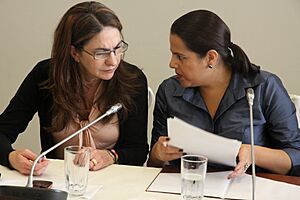United Nations Development Fund for Women facts for kids
 |
|
| Abbreviation | UNIFEM |
|---|---|
| Merged into | UN Women |
|
Parent organization
|
United Nations |
The United Nations Development Fund for Women (UNIFEM) was an important part of the United Nations. It started in December 1976. Its main goal was to help women around the world. UNIFEM provided money and support for projects. These projects aimed to improve women's human rights. They also helped women take part in politics. And they worked to make sure women had financial security.
From 1976, UNIFEM supported women's empowerment. This means helping women gain control over their lives. It also worked for gender equality, which means treating everyone fairly, no matter their gender. UNIFEM did this through its offices worldwide. It also worked with many women's groups. In 2011, UNIFEM joined with other groups. They became a new organization called UN Women.
Contents
What UNIFEM Did

UNIFEM was an independent group. It worked closely with the United Nations Development Programme (UNDP). Its job was to add to, not replace, the work of other UN agencies. UNIFEM helped fund projects that supported women and their families. It focused on helping women become "their own agents for change." This meant empowering women to make their own improvements.
UNIFEM also made sure that UN programs followed certain rules. These rules came from the Convention on the Elimination of All Forms of Discrimination Against Women (CEDAW). This agreement works to stop unfair treatment of women. UNIFEM also believed that women's rights are human rights. It promoted gender equality everywhere. The organization also saw women's rights as important for peace and safety.
UNIFEM got its money from donations. It was based in New York City. Different countries and regions had their own UNIFEM committees. UNIFEM was a smaller agency within the UN.
History of UNIFEM
The idea for UNIFEM came from the First World Conference on Women in 1975. Governments saw a need to invest in women's issues. So, the United Nations Voluntary Fund for the Decade for Women (UNVFDW) was created. This happened in December 1976. Margaret C. Snyder became the leader in 1978.
Changes in the 1980s
In February 1985, the UNVFDW got a bigger job. It was renamed the United Nations Development Fund for Women (UNIFEM). This new fund was asked to support new and important activities. These activities aimed to give a voice to women in developing countries. Funding for UNIFEM projects grew a lot between 1985 and 1988.
Focus in the 1990s
In the 1990s, UNIFEM started to work on more topics. It began a campaign to show that "women's rights are human rights." It also highlighted how violence against women affected economic growth. UNIFEM hired experts to show this connection. The "women's rights as human rights" campaign was very successful. UNIFEM started projects to reduce gender-based violence. It also worked to make people more aware of this problem.
Also in the 1990s, UNIFEM created African Women in Crisis (AFWIC). This group focused on problems faced by women in Africa. AFWIC helped women who had to leave their homes due to violence or emergencies.
UNIFEM's work helped shape the topics discussed at the Fourth World Conference on Women in 1995. Women at the conference decided it was important to have power. They wanted to directly influence public decisions.
UNIFEM also set up a special fund. This fund supported 23 projects. These projects worked to fight gender-based violence and war crimes against women. The fund started giving money to projects in 1997.
Developments in the 2000s
In 2000, UNIFEM gained "executing agency status" from UNDP. This meant UNIFEM could carry out projects for UNDP. These projects were related to women's rights and gender equality.
In 2001, UNIFEM released a new report. It was called Progress of the World's Women. This report showed what UNIFEM had achieved. Also in 2001, UNIFEM helped launch the Millennium Peace Prize for Women.
Noeleen Heyzer, who led UNIFEM, asked for a global group to study violence against women. On January 26, 2006, Nicole Kidman became a goodwill ambassador for UNIFEM. The last leader of UNIFEM was Inés Alberdi.
Merger in the 2010s
In January 2011, UNIFEM joined with three other UN groups. These were INSTRAW, OSAGI, and DAW. Together, they formed a new, larger UN organization. This new organization is called UN Women.
Leaders of UNIFEM
Here are the people who led UNIFEM:
| Nr | Director | From country | Term |
|---|---|---|---|
| 4. | Inés Alberdi | 2007–2014 | |
| 3. | Noeleen Heyzer | 1994–2007 | |
| 2. | Sharon Capeling-Alakija | 1989–1994 | |
| 1. | Margaret C. Snyder | 1978–1989 |
See also
 In Spanish: Fondo de Desarrollo de las Naciones Unidas para la Mujer para niños
In Spanish: Fondo de Desarrollo de las Naciones Unidas para la Mujer para niños
- United Nations Decade for Women
- UN Women

